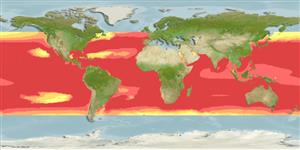分类 / Names
俗名 | 同种异名 | Catalog of Fishes(属, 种) | ITIS | CoL | WoRMS | Cloffa
Teleostei >
Scombriformes (Mackerels) >
Scombridae (Mackerels, tunas, bonitos) > Scombrinae
Etymology: Thunnus: Greek, thynnos = tunna (Ref. 45335).
More on author: Lowe.
Environment: milieu / climate zone / depth range / distribution range
生态学
海洋; 海洋洄游的 (Ref. 51243); 深度上下限 0 - 1500 m (Ref. 117020), usually 0 - 500 m (Ref. 117020). 亞熱帶的; 13°C - 29°C (Ref. 168); 52°N - 48°S, 180°W - 180°E
Atlantic, Indian and Pacific: in tropical and subtropical waters. Absent in the Mediterranean. Highly migratory species.
大西洋,印度洋與太平洋: 在熱帶與亞熱帶的水域中。 不存在於地中海。 高度遷移的種,1982年海事法會議的附件一.(參考文獻 26139)
Length at first maturity / 大小 / 重量 / 年龄
Maturity: Lm 112.5, range 100 - 125 cm
Max length : 250 cm TL 雄鱼/尚未辨别雌雄; (Ref. 27000); common length : 180 cm FL 雄鱼/尚未辨别雌雄; (Ref. 168); 最大体重: 210.0 kg (Ref. 9987); 最大年龄: 11 年 (Ref. 30326)
背棘 (总数): 13 - 14; 背的软条 (总数): 14-15; 臀棘 0; 臀鳍软条: 14; 脊椎骨: 39. This large species is distinguished by the following characters: robust, fusiform body, slightly compressed from side to side; total gill rakers on first gill arch 23-31; dorsal fins separated only by a narrow interspace, the second followed by 8-10 finlets; anal fin followed by 7-10 finlets; pectoral fins moderately long (22 to 31% of fork length) in large specimens (over 110 cm FL), but very long (as long as in Thunnus alalunga) in smaller specimens; 2 flaps (interpelvic process) between pelvic fins; very small scales on body; corselet of larger and thicker scales developed, but not very distinct; caudal peduncle very slender, with a strong lateral keel between 2 smaller keels; ventral surface of liver striated; swimbladder present. Colour of back metallic dark blue, lower sides and belly whitish; a lateral iridescent blue band runs along sides in live specimens; first dorsal fin deep yellow, second dorsal and anal fins light yellow, finlets bright yellow edged with black (Ref. 9684).
一个大的种, 深的在第一背鳍基底的中央的附近。 下侧与腹面微白色的; 一条侧面的蓝色虹彩的条纹在活体中沿着侧边。 第一背鳍是深黄色, 第二个背鳍与臀鳍是淡黄色的,离鳍是鲜黄色的被黑色边缘的。
Occur in areas where water temperatures range from 13°-29°C, but the optimum is between 17° and 22°C. Variation in occurrence is closely related to seasonal and climatic changes in surface temperature and thermocline. Juveniles and small adults school at the surface in mono-species groups or mixed with other tunas, may be associated with floating objects. Adults stay in deeper waters (Ref. 5377). Eggs and larvae are pelagic (Ref. 6390). Feed on a wide variety of fishes, cephalopods and crustaceans during the day and at night (Ref. 9340). Meat is highly prized and processed into sashimi in Japan. Marketed mainly canned or frozen (Ref. 9684), but also sold fresh (Ref. 9340).
出现在区域水温范围从 13个 °-29 °C, 但是最适宜在 17个 ° 与 22个 ° C. 之间 出现位置的变化在水表层与跃温层中是与季节和气候变化有密切的关系。 稚鱼与小的成鱼群集在表面以单一种类的形式或者混和着其他的鲔鱼了, 可能是伴随着漂浮的目标。 成鱼停留在较深的水域中。 (参考文献 5377) 卵与仔鱼是大洋性的。 (参考文献 6390) 捕食各式各样的鱼,头足类动物与甲壳动物在白天期间而在夜晚.(参考文献 9340) 肉在日本被高度地珍视而且加工成生鱼片。 主要地在市场上销售将或者装于罐头冻结 (参考文献 9684), 也卖了生鲜地.(参考文献 9340)
Life cycle and mating behavior
成熟度 | 繁殖 | 产卵场 | 卵 | 孕卵数 | 仔鱼
Are multiple spawners that may spawn every 1 or 2 days over several months (Ref. 30330). They spawn over periods of the full moon (Ref. 6390). Spawn throughout the year in tropical waters (Ref. 6390).大西洋,印度洋與太平洋: 在熱帶與亞熱帶的水域中。 不存在於地中海。 高度遷移的種,1982年海事法會議的附件一.(參考文獻 26139)
Collette, B.B. and C.E. Nauen, 1983. FAO Species Catalogue. Vol. 2. Scombrids of the world. An annotated and illustrated catalogue of tunas, mackerels, bonitos and related species known to date. Rome: FAO. FAO Fish. Synop. 125(2):137 p. (Ref. 168)
人类利用
渔业: 高经济性; 游钓鱼种: 是的
更多信息
参考文献养殖养殖信息品种遗传学Electrophoreses遗传率疾病加工NutrientsMass conversion
工具
特别资料
下载 XML
网络资源
Estimates based on models
Preferred temperature (Ref.
123201): 16.8 - 28.6, mean 26.6 °C (based on 3638 cells).
Phylogenetic diversity index (Ref.
82804): PD
50 = 0.5039 [Uniqueness, from 0.5 = low to 2.0 = high].
Bayesian length-weight: a=0.01318 (0.01039 - 0.01673), b=3.03 (2.99 - 3.07), in cm total length, based on LWR estimates for this species (Ref.
93245).
营养阶层 (Ref.
69278): 4.5 ±0.0 se; based on diet studies.
Generation time: 6.6 (4.4 - 10.4) years. Estimated as median ln(3)/K based on 12
growth studies.
回复力 (Ref.
120179): 中等的, 族群倍增时间最少 1.4 - 4.4年 (K=0.11-0.23; tm=3; tmax=11; Fec=2 million).
Prior r = 0.65, 95% CL = 0.43 - 0.98, Based on 5 stock assessments.
Fishing Vulnerability (Ref.
59153): High vulnerability (56 of 100).
Climate Vulnerability (Ref.
125649): Moderate to high vulnerability (47 of 100).
Nutrients (Ref.
124155): Calcium = 22.1 [12.0, 42.2] mg/100g; Iron = 2.65 [1.06, 6.93] mg/100g; Protein = 24 [23, 25] %; Omega3 = 0.453 [0.273, 0.754] g/100g; Selenium = 54.7 [17.4, 171.5] μg/100g; VitaminA = 19.6 [2.7, 180.1] μg/100g; Zinc = 0.278 [0.153, 0.561] mg/100g (wet weight);
